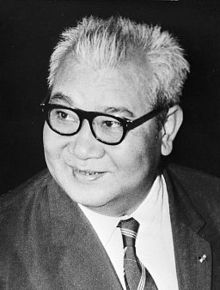Boun Oum
Prince Boun Oum of Champasak ( ເຈົ້າ ບຸນ ອຸ້ມ ນະ ຈຳ ປາ ສັກ , Chao Bunum na Champasak , also Prince Boun Oum na Champasak ; * 1911 or 1912 in Champasak (then Bassac, French protectorate of Laos); † March 17, 1980 in Boulogne-Billancourt , France) a Lao nobleman and politician. From 1949 to 1950 and from 1960 to 1962 he was Prime Minister of the Kingdom of Laos .
Life
Boun Oum was the eldest son of Nyouy Ratsadanay , the last ruling prince of Champasak in southern Laos under French protectorate . He studied in Saigon and from 1934 worked in the administration of the Laos Protectorate. Prince Boun Oum was loyal to the French colonial administration and fought with his troops both in World War II against the Japanese and against the national independence movement of the Lao Issara . He offered the French troops the area he controlled in southern Laos as a base for their recapture of the country.
After the death of his father in 1945, Boun Oum would actually have become the new head of Champasak, but he renounced his throne in favor of King Sisavang Vong of Luang Prabang in the interests of the unity of Laos . This made him king of all of Laos. However, Boun Oum retained the title of Prince of Champasak and became Inspector General of the Kingdom for life. In 1947 he became a member of the Privy Council of the Kingdom of Laos, which in that year became an independent member of the Union française . In March 1949 he became Prime Minister. He resigned after the Lao Issara government in exile dissolved in February 1950 and its members returned to Laos. His successor was Phoui Sananikone .
Behind the scenes, Prince Boun Oum continued to influence Laotian politics, representing the interests of the southern region, which often made him an opponent of the royal court in Luang Prabang. In the First Lao Civil War (1958-61) he was the figurehead of the pro-American right. After they took the capital in the Battle of Vientiane in December 1960, he was again head of government. However, he held talks with the disempowered neutralist Prime Minister Prince Souvanna Phouma and the highest-ranking member of the Communist Pathet Lao , Prince Souphanouvong . Together they were referred to as the "three princes". They agreed to form an all-party government, for which Boun Oum gave up his post in June 1962.
In the following years, Boun Oum was hardly politically active. He switched to his economic ventures in his home region: plantations, cinemas and a casino. He also had new residences built for himself and his family in Champasak and Pakse. Due to the increasing dominance of the communists, Boun Oum fled to neighboring Thailand in 1974. In 1975 he went to France for medical treatment, from where he did not return after the proclamation of the People's Democratic Republic of Laos in December. He died in the Paris suburb of Boulogne-Billancourt , his ashes were buried in the Meudon cemetery.
literature
- Timothy N. Castle: At War in the Shadow of Vietnam. US Military Aid to the Royal Lao Government, 1955-75. Columbia University Press, New York 1995.
- Bun Um , in: Internationales Biographisches Archiv 22/1980 from May 19, 1980, in the Munzinger archive ( beginning of article freely available)
Individual evidence
- ↑ a b Jacques Dalloz: Dictionnaire de la Guerre d'Indochine, 1945-1954. Armand Colin, 2006, keyword “Boun Oum”.
- ^ A b Martin Stuart-Fox : Historical Dictionary of Laos. 3rd edition, Scarecrow Press, 2008, p. 29
- ^ A b c Martin Stuart-Fox: Historical Dictionary of Laos. 3rd edition, Scarecrow Press, 2008, p. 30
| personal data | |
|---|---|
| SURNAME | Boun Oum |
| ALTERNATIVE NAMES | Chao Bunum na Champasak; Boun Oum na Champasak; Bun Um; ເຈົ້າ ບຸນ ອຸ້ມ ນະ ຈຳ ປາ ສັກ (Lao) |
| BRIEF DESCRIPTION | Laotian nobleman and politician |
| DATE OF BIRTH | uncertain: 1911 or 1912 |
| PLACE OF BIRTH | Champasak (then Bassac, French protectorate of Laos) |
| DATE OF DEATH | March 17, 1980 |
| Place of death | Boulogne-Billancourt , France |

